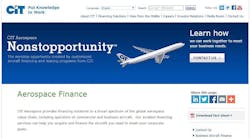Asian airlines likely to require 13,000 new aircraft, says CIT Aerospace
NEW YORK, 5 Nov. 2014. Some aerospace industry pundits speculate that Asian airlines may have ordered too many aircraft, resulting in excess capacity. Several subregions, including China and East Asia, likely have not ordered enough, according to CIT Aerospace, a global aircraft finance division of CIT Group Inc. (NYSE:CIT).
Asian carriers may have excess capacity in the short term, says Steve Mason, vice president of aircraft analysis at CIT Aerospace. Traffic is projected to grow by 6 percent annually, so the region will need approximately 13,000 new aircraft over the next 20 years, he says. These views and others are presented in “Clear Skies or Turbulence Ahead for the Asian Aircraft Order Book?” (cit.com/mason), the latest piece of market intelligence to be featured in the CIT Executive Insights series (cit.com/executiveinsights).
“Aircraft manufacturers take orders for more aircraft than they expect to produce, which shields them from a slump in actual orders and protects their shareholders,” Mason adds. “As Asian carriers put in place more capacity discipline than in years past, we must realize that aircraft orders will fall in line with projected growth over a longer timeline.”
Softening yields and declining load factors across the region are exacerbating concerns about a long-term surplus, but analysis of capacity and demand patterns in the Asian market show that the current commitment for seat growth among Asian carriers is in line with traffic predictions through 2020, according to Mason.
The balance between capacity constraint and aircraft order discipline ultimately may be determined by the rise of Asia’s low cost carriers (LCCs). Their aggressive seat growth in Asia follows an established pattern of capacity expansion in the more mature LCC markets in North America and Europe. Currently, LCCs account for approximately 20 percent of the intra-Asian market, compared with a 45% share held by their counterparts in Europe.
Additional considerations for the Asian airline sector include:
Order bubble speculation is in part driven by the unprecedented level of new technology aircraft entering the market. Not only must airlines wait for a position on the manufacturing schedule, but they must also wait for the design, development, testing and ramp up phases of new models. This has caused aircraft to sit on the order book for longer periods than seen previously.
Similar to North America and Europe, consolidation is inevitable across the commercial aviation industry in Asia. However, political, nationalistic and regulatory issues remain significant barriers to consolidation.
If capacity discipline is not being complemented by similar discipline in aircraft orders, airlines could wind up with expensive new aircraft that are not being fully utilized.
The LCC penetration rate within Asia is 20 percent in terms of available seat miles, leaving ample room to expand across Asia by offering more affordable tickets.
CIT Aerospace provides customized leasing and secured financing to operators of commercial and business aircraft. Our financing services include operating leases, single investor leases, leveraged financing, sale and leaseback arrangements, as well as loans secured by equipment.


